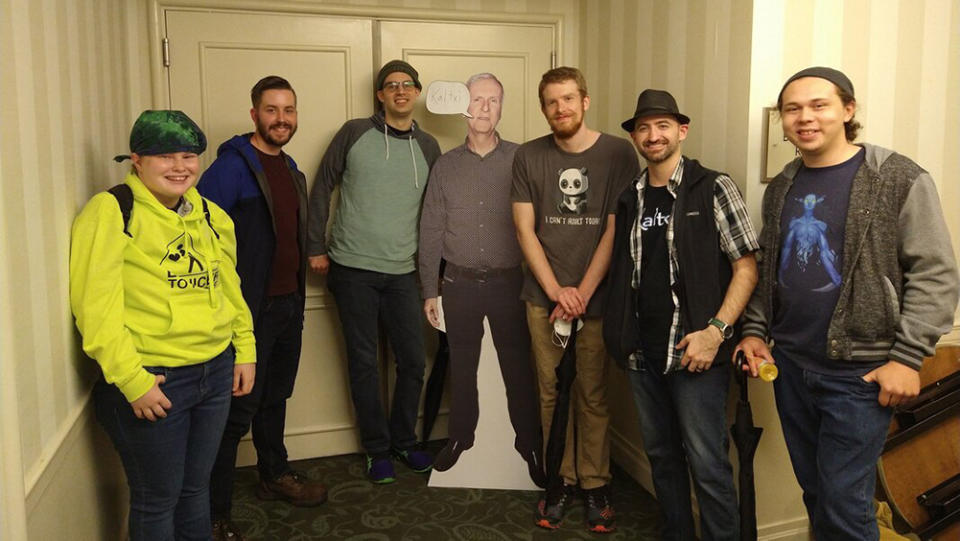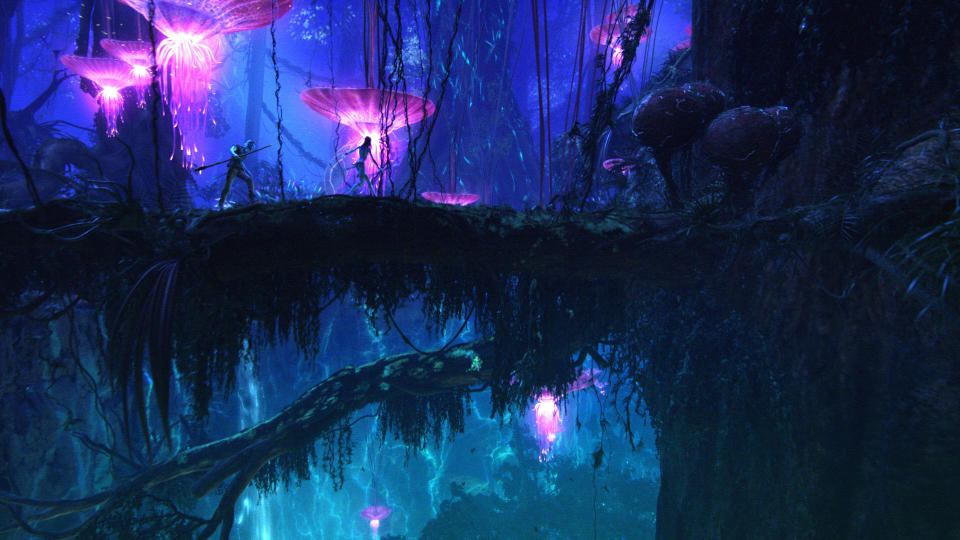
When “Avatar” first hit theaters in 2009, audiences had never seen anything quite like it before. James Cameron’s science-fiction spectacle became a phenomenon, transporting repeat viewers to the colorful alien world of Pandora: a digitally realized environment of sprawling forests, floating mountains and majestic creatures.
But in the weeks following the release of “Avatar,” CNN reported that some viewers were experiencing “depression and suicidal thoughts.” A gloomy sentiment had taken root in tandem with the euphoric praise: Earth’s surfaces seemed gray compared to the film’s gorgeous vistas — and the quotidian ways of mankind felt dull and restrictive compared to the symbiotic tranquility of the Na’vi, the race of blue humanoids native to Pandora.
More from Variety
The phenomenon, referred to as “post-‘Avatar’ depression” among the fan community, cast a shadow beyond the film’s original release. Max Perrin, a 24-year-old digital artist living in Texas, had an intense emotional experience much later than the first crop of viewers; he didn’t see the film until 2017.
“A lot of people have experienced this in the community,” Perrin tells Variety. “It really made me rethink a few things. I had no idea that I could be so deeply influenced by something like this. I had no idea just how deeply it was going to change me.”
Jacob Williamson, a 25-year-old physicist living in Atlanta, Ga., was also a latecomer to post-“Avatar” depression. While Williamson was among the masses who saw “Avatar” during its premier theatrical run, it wasn’t until years later that he recognized that he had acquired a worrying fixation on Pandora.
“The first time I experienced it was probably several years after, just rewatching it on Blu-ray,” Williamson says. “I reexperienced it in 2018 after visiting Pandora — The World of Avatar at Disney World. It actually ended up taking me out of school for a semester.”
Perrin and Williamson are both members of Kelutral, an online “Avatar” fan community established on the messaging app Discord. Since its formal launch in 2020, Kelutral has aimed to provide a conversational space for all “Avatar” fans, but it began as a group of people interested in learning and conversing in the Na’vi language.


Kelutral gained somewhat of a spotlight last fall, featuring in the HBO series “How to With John Wilson.” The episode, titled “How to Remember Your Dreams,” documented a humble conference of Kelutral members in New York. Williamson and Perrin appear in the segment, as does Kelutral user experience designer Nick Paavo, a 33-year-old video game developer and musician living in Massachusetts.
While Paavo says that he hasn’t personally experienced a form of post-“Avatar” depression, he finds himself embedded in a community where he estimates “roughly 10 to 20%” of his peers were affected by the film in that way.
“Empathizing with and understanding it is part of who I am,” Paavo says. “Now, it’s definitely dwindling… If you were experiencing post-‘Avatar’ depression, the odds of you having been with us through the gap between movies was pretty high. People coming in now were very fine living their lives without ‘Avatar.’”


Perrin was one of the people that Paavo has talked with about post-“Avatar” depression. The Kelutral community has played a part in several dramatic changes to Perrin’s life.
“I remember being blown away by the visual spectacle of it and the compositions and emotional beats of the story. I went in blind and I was swept off my feet,” Perrin shares. “I was kind of in tears. I was also just like, ‘I need to talk to somebody about this’… That’s when I found a Discord server, where I met what is now known as the Kelutral community. I was just ecstatic.”
Perrin, who has a lifelong fascination with linguistics, found a support network in the Na’vi-speaking channels of Kelutral. While post-“Avatar” depression took a toll on him, the group helped Perrin find the language to recognize his own mental health troubles.
“I felt like that was an amazing dream, but now I had to wake up. I had to return to the doldrum of reality, trying to figure out what I was going to do with my adult life,” Perrin says, recalling his experience after seeing “Avatar.” “I had been struggling with depression and I didn’t know what it was. I didn’t have a name for it. I was not allowed to seek out mental medical treatments, psychotherapy or anything like that. My family had religious views that were diametrically opposed to a lot of science and medicine.”
After tensions with Perrin’s father came to a head, one of Kelutral’s community leaders offered him a ride from Arizona to Texas and a roof to sleep under, providing a safe space for Perrin as he began to set the foundation for a new life.
“They’ve been a family that I didn’t know I could ever have,” Perrin shares. “I never thought that my life would be so changed for the positive when I saw some movie about blue space aliens.”


Williamson has also worked on his relationship with “Avatar,” reconciling a longing to engage with the property with its potential for it to trigger his depression. The solution he found worked best for him was simply allowing himself to be fully drawn in — a credo he has shared with others.
“I talked to my psychiatrist about it and she had a piece of advice I was not expecting: Let yourself do it. Stop trying to stop yourself,” Williamson says, recalling the weeks after he had exited college for a semester. “I watched ‘Avatar’ repeatedly, delved into the language community and started learning Na’vi… After a week or so, it stopped. I’ve never had an incident since.”
Now, the “Avatar” community is entering uncharted waters: the release of another series entry — and an epic-length, even more technically dazzling one at that. Putting aside a Disney World attraction, a few derided video games and a handful of recent graphic novels, “Avatar” fans have largely been driven by self-sustaining enthusiasm, fixating on a single film for over a decade. “The Way of Water” will make waves in the community like nothing has before. While helping run Kelutral, Paavo has observed a number of members pondering the potential mental health impact of a return to Pandora.
“There’s definitely been a couple of people — less than you could count on one hand — who have mentioned, ‘Man, I’m worried that this is going to hit me different,’” Paavo shares. “Most of us are blinded by excitement; we’re not even thinking about the possible consequences of what the world looks like after this movie.”
For Williamson, there aren’t many hard narrative expectations for “The Way of Water”; the promise of finally expanding the scope of Pandora is more than enough to whet his appetite. But while he’s bracing for an intense emotional viewing experience, Williamson seems confident in his ability to weather it.
“There’s always that little bit of concern that it might trigger me again… I could see it being slightly less emotional in the sense that it is a return to Pandora. But, since we’re exploring new areas that we haven’t seen before, it does still have that shock of the new,” Williamson says. “I don’t think I’ll know until I see it.”
[embedded content]
As for Perrin, he’s particularly excited about the linguistic implications of the new film, which could broach a new Na’vi dialect through the story’s introduction of the Metkayina clan, a group that lives along Pandora’s reefs.
“I didn’t want a life that was free of problems. It was just that the problems of the world of ‘Avatar’ seemed more overcomeable than my own problems,” Perrin says, reflecting on his post-“Avatar” depression and his time before moving to Texas. “It’s going to be a very introspective time for me. I don’t think it’s going to be as negative as a lot of people’s first post-‘Avatar’ depression. It is going to be more solemn, sentimental and retrospective.”
The peculiarity of Perrin’s circumstances isn’t lost on him; most life trajectories aren’t shaped by a single sci-fi blockbuster. But after finding a support system through Kelutral, “The Way of Water” isn’t just a long-awaited return to an alien world he loves. It’s a hard-fought moment of triumph.
“This is a movie about blue space cats,” Perrin chuckles. “There’s a good portion of people that are like, ‘“Avatar 2?” Did we really need this movie?’ Yes. Yes, we did.”
Best of Variety
Sign up for Variety’s Newsletter. For the latest news, follow us on Facebook, Twitter, and Instagram.



